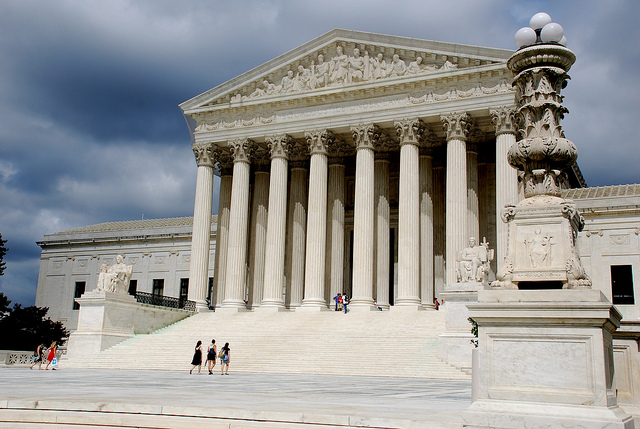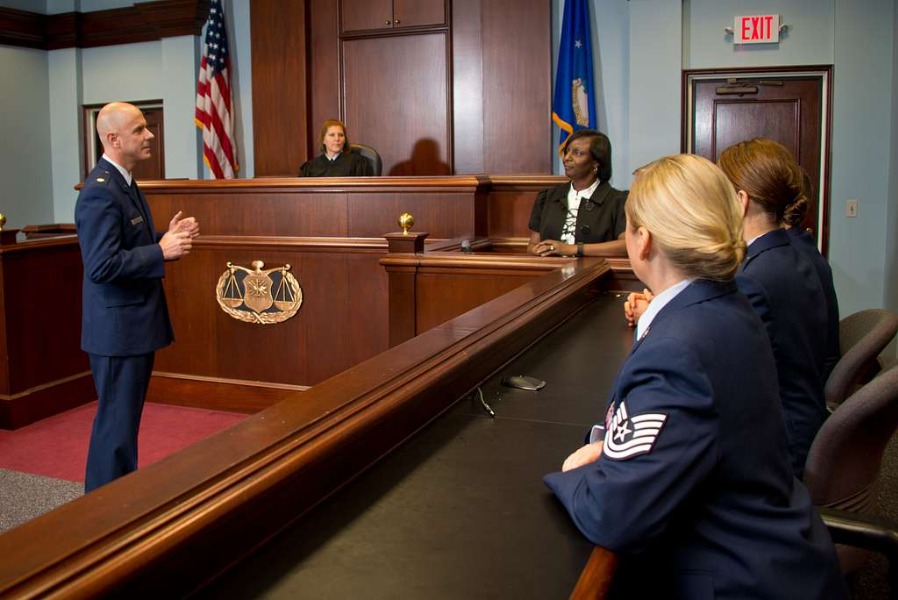Trump’s Travel Ban at the Supreme Court: Deference Joined by Nudges Toward Civility

Published by The Lawfare Institute
in Cooperation With

As I expected, the Supreme Court has upheld President Trump’s travel ban (EO-3). The court’s traditional deference to the president on foreign affairs and national security drove the 5-4 decision, in which Chief Justice John Roberts (joined by Justices Anthony Kennedy, Clarence Thomas, Samuel Alito and Neil Gorsuch) rejected both statutory and constitutional challenges to Proclamation No. 9645, which followed two executive orders. Both Chief Justice Roberts and Justice Kennedy, concurring in the judgment, offered critics of the ban a bit of a silver lining: The justices sought to nudge the president toward more civil rhetoric and overruled Korematsu v. United States, the infamous decision upholding the conviction of a U.S. citizen who had failed to comply with a military evacuation order amid the internment of Japanese-Americans during World War II. But the majority rejected claims that the proclamation exceeded the scope of congressional delegation under the Immigration and Nationality Act (INA) or violated the Constitution’s Establishment Clause.
On the statute, Chief Justice Roberts asserted that Congress had clearly delegated broad authority to the president under 8 U.S.C. 1182(f). That provision empowers the president to deny entry to foreign nationals when entry would be “detrimental to the interests of the United States.” According to Roberts, EO-3’s ban on entry of immigrants from several Muslim-majority countries—including Iran, Libya, Somalia, Syria and Yemen—was the product of a neutral interagency process that “sought to improve vetting procedures” in those countries. The chief justice viewed 1182(f)’s “sweeping” language as sufficient to authorize measures that retaliated for other governments’ failure to ensure the flow of information necessary for appropriate consular decisions.
Unfortunately, the majority’s broad view of 1182(f)’s delegation missed its more tailored role in the INA’s overall plan (see the amicus brief for immigration scholars on which I served as co-counsel with Shoba Wadhia of Penn State and WilmerHale’s Alan Schoenfeld, Ben Gifford and Francisco Unger). In enacting the modern INA in 1965, Congress assumed that State Department consular officers all over the world would apply their expertise and judgment to decisions on visa applications. Resolving uncertainties in vetting visa applications is part and parcel of consular officials’ role. The blanket presidential authority that the majority envisions would displace that role. Moreover, the authority claimed by Trump lacks any intelligible limits. No prior president has invoked 1182(f) as support for a sweeping bar on immigration from multiple countries. Expanded to the limits of its logic, the power asserted by the president would swallow up the INA’s entire scheme, including Congress’s elevation of family reunification to the INA’s “foremost” priority.
That runaway power would also frustrate Congress’s intent in 1965 to decisively reject the national origin quotas that had dominated U.S. immigration law for decades—quotas roundly denounced by presidents of both parties, including Harry Truman, Dwight Eisenhower, John Kennedy and Lyndon Johnson. In enacting 8 U.S.C. 1152(a)(1)(A), which bars national-origin discrimination in the issuance of immigrant visas, Congress sought to prevent administrative backsliding toward the discredited quota regime. Unduly discounting Congress’s intent, Roberts’s anodyne account of EO-3 as a neutral product of interagency review blinked at its arbitrary singling out of nationals from particular countries that largely share one material attribute: a Muslim-majority population. The INA’s antidiscrimination mandate makes such stark distinctions the province of Congress, not the executive.
While the challengers argued that EO-3 clashes with the INA’s antidiscrimination mandate, the majority opinion relied on a formalistic distinction between 1182(f)’s grant of presidential authority over “entry” of foreign nationals to the United States and 1152(a)(1)(A)’s prohibition on discrimination in issuance of immigrant visas (see Josh Blackman’s analysis here). According to Roberts, there was no clash between Trump’s broad reading of 1182(f) and the INA’s nondiscrimination provision; the two provisions occupy “different spheres.” According to this view, visa issuance merely addresses threshold eligibility for a visa, including ascertaining that a visa applicant is a close relative of his or her sponsor or fits within other visa criteria. For Roberts, admissibility concerns a wholly separate inquiry that addresses whether the applicant has committed a crime, engaged in terrorism, suffers from a communicable disease such as tuberculosis or in any other way runs afoul of express conditions in the INA.
But Roberts’s analysis arbitrarily bifurcates eligibility and admissibility determinations. Consular officials routinely make both determinations before they issue a visa. And a consular official’s denial of a visa based on national security inadmissibility grounds was the subject of a 2015 decision cited approvingly by the majority: Kerry v. Din. It’s true that immigration officials at U.S. ports of entry can bar admission of newly arriving foreign nationals if those officials determine that the noncitizen has committed a crime or is otherwise inadmissible. As a practical matter, however, this power is triggered only based on new evidence not available to the consular official who approved the visa. Under the INA, primary responsibility for both eligibility and admissibility decisions resides with consular officials. The majority’s mechanistic distinction ignores this ground truth of immigration practice.
Having rejected the challengers’ statutory argument, the majority also finds their constitutional argument unavailing. Here, along with Josh Blackman, I agree with the Supreme Court’s reasoning. The majority seemed concerned that application of the court’s usual de novo “reasonable observer” approach to the Establishment Clause would prove “problematic” (p. 32 n. 5) in the unfamiliar context of national security and foreign affairs. The majority was right that caution is prudent in subjecting national security decisions to the tangled case law of the Establishment Clause, which typically handles disparate matters such as religious displays. Rather than go this route, which could spill over into judicial intrusion on prerogatives of the political branches, Roberts applied a more deferential rational-basis test. For the majority, this test was satisfied by EO-3’s facial neutrality, its inclusion of only 8 percent of the world’s Muslim population, and its inter-agency pedigree and relation to legitimate national security concerns.
I would have preferred that the Supreme Court avoid the mismatch of Establishment Clause jurisprudence and national security subject matter by holding that EO-3 exceeded Congress’s delegation to the president under the INA. However, I agree with the majority that the risk of structural spillover was too great to enter the Establishment Clause thicket.
Yet the evidence presented by the plaintiffs in support of their Establishment Clause argument—statements by Trump as both a candidate and as president, including his campaign advocacy of a “total and complete shutdown of Muslims entering the United States”— spurred perhaps the most remarkable material in both the majority opinion and Justice Kennedy’s concurrence. Weighing the president’s comments, Roberts asserted that they did not outweigh the putatively neutral basis for EO-3. But Roberts seemed to suggest that an even more egregious set of statements, together with a more attenuated national security justification, would fail the rational-basis test.
Thus far, Roberts had strictly adhered to judicial deference. But here he diverged from that path in citing one of the most celebrated examples of presidential speech: President George Washington’s reassurance to the Hebrew Congregation of Newport, Rhode Island, that the government of the United States lends “bigotry no sanction” and “persecution no assistance.” Building on this theme, Roberts next cited President Eisenhower’s vow to congregants at a Washington Islamic Center that “America would fight” for their religious freedom, and George W. Bush’s solemn request after the Sept. 11 attacks that Americans of all faiths understand that “[t]he face of terror is not the true faith of Islam.” In an implicit but unmistakable allusion to Trump’s rhetoric, Roberts observed with consummate understatement that presidents and the federal government as a whole have “performed unevenly in living up to those inspiring words.”
In another implicit yet unmistakable reference, this time addressing the Supreme Court’s own checkered history, the majority overruled the court’s infamous decision in Korematsu. During the presidential campaign, in an exchange that drew substantial attention, then-candidate Trump was distressingly coy when asked whether he would have supported the internment of Japanese-Americans during World War II. But here, Roberts labeled the internment “morally repugnant” and pronounced the court’s decision in Korematsu as “gravely wrong” then and now. Roberts cited Justice Robert Jackson’s dissent, which averred that the internment had “no place in law under the Constitution.”
Justice Kennedy’s concurrence dovetailed with these themes, noting succinctly that the “oath that all officials take to adhere to the Constitution is not confined to those spheres in which the Judiciary can correct or even comment on what those officials say or do.” For Kennedy, that absence of judicial oversight made it “all the more imperative” that each official “adhere to the Constitution and to its meaning and its promise.” Kennedy’s concurrence left little doubt that he would have been inclined to be more specific about Trump’s rhetoric had he occupied a different role.
The Supreme Court’s plea for civility is only dicta, to be sure. It does not compensate for the majority’s failure to recognize that EO-3 clashes with the INA. Nor does it concretely assist U.S. citizens and lawful permanent residents hoping for reunification with family members from countries covered by the travel ban. However, as Leah Litman has noted, the court’s words reinforce that constitutionalism is ultimately a job for the people themselves.





